
Reed is a common name for several tall, grass-like plants of wetlands.
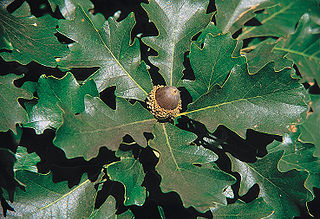
Quercus macrocarpa, the bur oak, sometimes spelled burr oak, is a species of oak in the white oak section Quercus sect. Quercus, native to North America in the eastern and central United States and eastern and central Canada. This plant is also called mossycup oak and mossycup white oak.

Birdling's Flat, originally named Te Mata Hapuku, is a settlement in Canterbury, New Zealand, close to the shore of Lake Ellesmere / Te Waihora.
Bolshayne Fen is a wetland in southeast Devon, England. It has an area of 1.62 hectares.

The River Rom, also known as the River Beam below its confluence with the Ravensbourne, is a tributary of the River Thames in England that flows through east London suburbs surrounding the metropolitan centre of Romford, forming the boundary between the London boroughs of Barking and Dagenham and Havering. The Rom is culverted for a brief midsection as it passes through the centre of Romford.
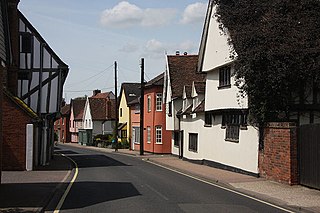
Bures is a village with many amenities in eastern England that straddles the Essex/Suffolk border.
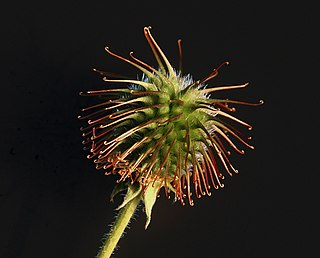
A bur is a seed or dry fruit or infructescence that has hooks or teeth.

Street Heath is a 12.5 hectare biological Site of Special Scientific Interest 4 km west of Glastonbury in Somerset, notified in 1966. It next to the Glastonbury Canal and Ham Wall nature reserve. Street Heath has itself been designated as a Local Nature Reserve.

Sparganium natans is a species of bur-reed known by the common names least bur-reed and small bur-reed. It is a water circumboreal plant inhabiting North America, Europe, West Asia and Japan. It is usually found submersed in shallow, calm water. This bur-reed has thin, flexible, grasslike leaves which float in the water. Plants that spend more time out of water at the waterline are tougher and have shorter leaves. The plant bears two inflorescences, the staminate type being a rounded white filamentous ball and the pistillate type a sphere of thick, green, pointy peduncles. The fruits are small green or brown achenes.

Sparganium eurycarpum is a species of bur-reed known by the common names broadfruit bur-reed and giant bur-reed. It is native to wetlands in Eurasia and North America. It is a clonal perennial, spreading by below-ground rhizomes. The common name, bur-reed, arises from the distinctive round clusters of fruits that take the form of a mace. It can be distinguished from all other species of bur-reed by the presence of two stigmas.
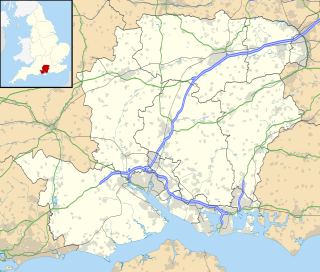
Trodds Copse is a 25.23 hectare biological Site of Special Scientific Interest (SSSI), in central Hampshire, notified in 1989. It comprises ancient semi-natural woodland, unimproved meadows and flushes.

Sparganium angustifolium is a species of flowering plant in the cat-tail family known by the common names floating bur-reed and narrowleaf bur-reed. It has a circumboreal distribution, occurring throughout the northern latitudes of the Northern Hemisphere. It is an aquatic plant, growing in water up to 2.5 meters deep. Its habitat includes acidic, low-nutrient freshwater bodies such as ponds, lakes, slow-moving streams, and ditches. It can become abundant, practically covering the surface of the water. It is a perennial herb producing a floating stem with long, narrow, flattened leaves which can be quite long, sometimes reaching over two meters. It is monoecious, individual plants bearing both male and female inflorescences. These are spherical, the male inflorescence a ball of stamens and the female inflorescence a ball of developing fruits.

Sparganium emersum is a species of flowering plant in the cat-tail family known by the common names European bur-reed and unbranched bur-reed. It has a circumboreal distribution, occurring throughout the northern latitudes of Eurasia and North America. It is an aquatic plant, growing in shallow water bodies such as ponds and streams. It can become abundant at times. It is a perennial herb producing a floating stem up to 2 meters long. The leaves may be limp and floating or stiff and erect, emerging above the water surface. The leaves are flat and straplike, sometimes with a triangular, keeled base that can help distinguish it from the similar Sparganium angustifolium. It is monoecious, individual plants bearing both male and female inflorescences. These are spherical, the male inflorescence a ball of stamens and the female inflorescence a ball of developing fruits growing beneath the male spheres.

Sparganium glomeratum, the clustered bur-reed, is a species of bur-reed. It is a water plant native to high elevation lakes and marshes of Europe, Asia, and North America. North American populations were doubted as introduced due to its scarce and scattered populations, but a recent herbarium survey found more localities of the species in the central of Canada, concluding the species as circumpolar species.
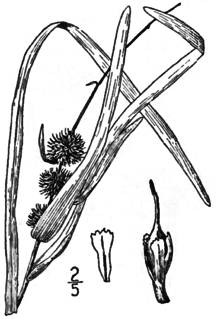
Sparganium americanum, American bur-reed, is a perennial plant found in the United States of America and Canada. Though this species resembles a grass, it is a type of bur-reed. This species is important for conservation purposes because it has the ability to remove nitrogen and phosphorus runoff from water, like many other wetland species. By doing this it protects waterways from excess nitrogen which can cause eutrophication. This increased nitrogen is especially a problem during the farmers’ growing season. During this same time frame the S. americanum is growing and taking up nitrogen.
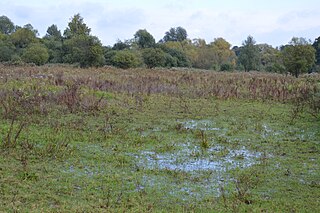
Little Hallingbury Marsh is a 4.5 hectare biological Site of Special Scientific Interest adjacent to the River Stort, west of Little Hallingbury in Essex. It was notified under Section 28 of the Wildlife and Countryside Act 1981, and the local planning authority is Uttlesford District Council.

Machynys Ponds is a Site of Special Scientific Interest (SSSI) in Carmarthenshire, Wales, designated in 1993 for its botanical features.

















